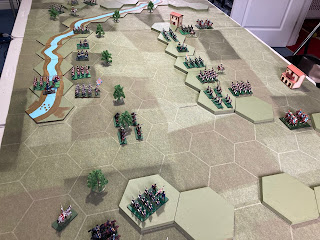Part 1
Today Will visited, providing the opportunity to play a game or two:
Operation Market Garden is a battle, or series of battles I have wanted to try for a long time. I have had an eye on the Memoir '44 scenario, which is played using the 'Overlord' rules. The map is enormous and quite complex. To make things even more problematic, I wanted to use figures on a wargames table. After pondering for a while, I decided upon 1/300th scale figures and vehicles. I already had most of the stuff needed to represent XXX Corps as well as the 1st Airborne Division. The Germans were also largely catered for and I just needed to make up some more infantry units. Most of the scenery was also available.
This is the Memoir '44 scenario (north is on the left):
As can be seen, although complicated, it is a rather simplified version of the campaign map. The many waterways and canals are reduced down to the three main crossings; Arnhem, Nijmegen and the Meuse/Wilhelmina Canal bridge to the north of Eindhoven (I assume this to be the Grave bridge).
As I planned to use figures I decided upon a larger battlefield, which was set out on an 8 x 4 table. Here is a picture taken during the setting up. Arnhem is closest to the camera, then Nijmegen, with Eindhoven in the distance, with the three main water obstacles clearly visible:
The battle begins on September 17th 1944, the landings have taken place and minor rivers and mopping up of isolated German units is complete. However; the germans are now alerted and are pushing reinforcements into the area from the east.
Here are the opening stages. The British 1st Airborne Division has landed west of Arnhem and is starting to move towards the town in an attempt to seize the bridge (top right), while the US 82nd Airborne Division has landed south and west of Nijmegen, tasked with capturing the town and its bridge (top left):
XXX Corps cross the start line (the bridge is missing!):

In the area of Eindhoven, US paratroops of the 101st Airborne Division have landed between the town and the Grave bridge. German reinforcements are on the move and in the distance, top left, the leading elements of XXX Corps can be seen.
The 101st attempt to rush into Einhoven to secure the route for XXX Corps and a brisk battle breaks out.
Meanwhile, the 82nd Airborne begin to move towards Nijmegen, which is strongly held by german infantry.
Up in the north, the British begin to advance from the landing ground:
Back in Eindhoven elements of the 101st become embroiled in a battle on the northern outskirts of the town and take heavy casualties:
The 101st hopes are raised as tanks of XXX Corps begin to engage the Germans in villages to the south of Eindhoven. However, German tanks arrive and begin to drive the US paratroopers out of the northern outskirts:
The 101st are forced back away from the bridge. One of their landing grounds are captured, but US anti-tank guns also reduce the german tanks. despite managing to force back the 101st and halt the XXX Corps advance only a small element of the original German force clings on to the town.
Up in the north the British airborne reconnaissance dash forward in their jeeps and ambush some German armour, but take heavy casualties.
The German column is severely mauled, but the remaining tanks destroy the jeeps and their crews:
Despite the heroics of the recce jeeps, this does not stop more heavy armour rolling into Arnhem town, although a parachute battalion manages to get into the eastern woods, but with heavy casualties. The newly arrived tanks begin to cut up the lightly armed british paratroopers.
Some help comes in the shape of some RAF Typhoons, but they cause little damage and the tanks maintain their onslaught.
German infantry sweep away the remnants of the parachute battalion
The German infantry move into the town as more infantry rush forward along the far side of the river.
Another allied airstrike comes in, this time it is US P-51s. This time the effect is much more damaging and several tanks are destroyed. But, the British paratroops are unable to enter the town and capture the bridge.
Back down towards Eindhoven the 101st Airborne, now with support from the tanks and artillery of XXX Corps clear the last german resistance from the town. The US paratroopers capture the bridge over the Meuse.
The leading tanks of XXX Corps cross the Meuse, via the Grave Bridge.
However, the 82nd are far from taking the Nijmegen Bridge and the German are massing reinforcements in the town.
Unfortunaetly Will had to depart rather urgently and so the battle was suspended at this point. I am hopin to continue in a few days time.
























































